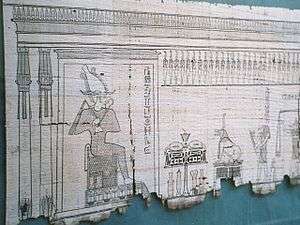Duat
| Part of a series on |
| Ancient Egyptian religion |
|---|
 |
|
Beliefs |
|
Practices |
|
|
|
Related religions |
|
|
Duat (pronounced "do-aht") (also Tuat and Tuaut or Akert, Amenthes, Amenti, or Neter-khertet) was the realm of the dead in ancient Egyptian mythology. It was the realm of the deity Osiris and the residence of other gods and supernatural beings. The Duat was the region through which the sun god Ra traveled from west to east during the night, and where he battled Apep. It was also the place where people's souls went after death for judgement, though that was not the full extent of the afterlife.[1] Burial chambers formed touching-points between the mundane world and the Duat, and spirits could use tombs to travel back and forth from the Duat.[2]
What is known of the Duat derives principally from funerary texts such as the Book of Gates, the Book of Caverns, the Coffin Texts, the Amduat, and the Book of the Dead. Each of these documents fulfilled a different purpose and gave a different perspective on the Duat, and different texts could be inconsistent with one another. Surviving texts differ in age and origin, and there likely was never a single uniform interpretation of the Duat.[3]

The geography of Duat is similar in outline to the world the Egyptians knew. There are realistic features like rivers, islands, fields, lakes, mounds and caverns, along with fantastic lakes of fire, walls of iron and trees of turquoise. In the Book of Two Ways, one of the Coffin Texts, there is even a map-like image of the Duat.[4]
The Book of the Dead and Coffin Texts were intended to guide people who had recently died through the Duat's dangerous landscape and to a life as an akh or blessed spirit amongst the gods. The dead person must pass a series of gates guarded by dangerous spirits, depicted as human bodies with grotesque heads of animals, insects, torches or knives.[5] These beings have equally grotesque names, for instance "Blood-drinker who comes from the Slaughterhouse" or "One who eats the excrement of his hindquarters".[6] Other features emphasised in these texts are mounds and caverns, inhabited by gods or supernatural animals, which threatened the spirits of the dead. The purpose of the books is not to lay out a geography, but to describe a succession of rites of passage which the dead would have to pass to reach the afterlife.[7]
If the deceased successfully passed these unpleasant demons, he or she would reach the Weighing of the Heart. In this ritual, the heart of the deceased was weighed by Anubis, using a feather, representing Ma'at, the goddess of truth and justice. Any hearts heavier than her feather were rejected and eaten by the Ammit, the Devourer of Souls. Those souls that were lighter than a feather passed the test would be allowed to travel toward the paradise of Aaru.
In spite of the unpleasant inhabitants of the Duat, this was no Hell to which souls were condemned; the nature of Duat is more complex than that. The grotesque spirits of the underworld were not evil, but under the control of the Gods.[8] The Duat was also a residence of gods themselves; as well as Osiris, Anubis, Thoth, Horus, Hathor and Ma'at all appear as a dead soul makes its way toward judgement. It was also in the underworld that the sun, Ra, travelled under the Earth from west to east and was transformed from its aged Atum form into Khepri, the new dawning Sun. Just as a dead person faced many challenges in the Duat, Ra faced attack in the underworld from the evil serpent Apep.[9]
References
Bibliography
- Faulkner, R. (translator): "The Egyptian Book of the Dead: The Book of Going Forth by Day". Chronicle Books, 2000
- Pinch, G.: "Magic in Ancient Egypt". British Museum Press, 1994
- Taylor, John (editor): "Ancient Egyptian Book of the Dead". British Museum Press, 2010.
External links
| Wikimedia Commons has media related to Duat. |

